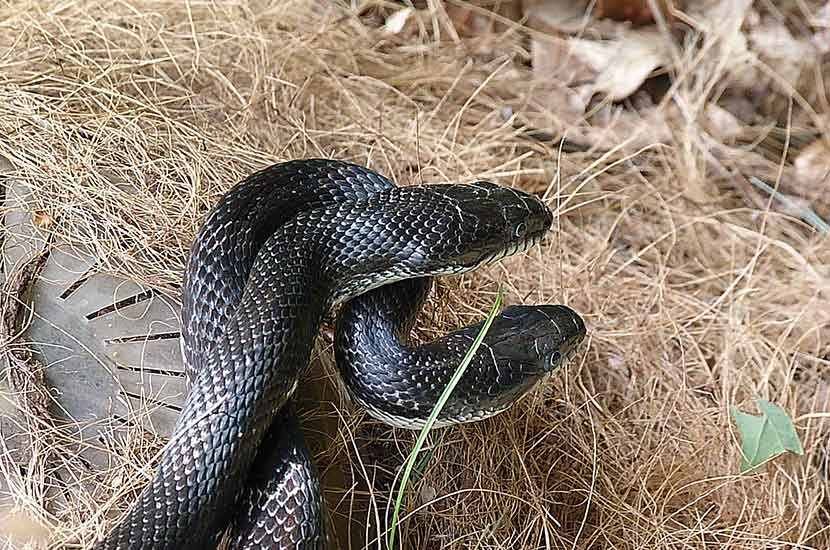Description
Black Rat snakes are also called the Pilot snake since this species was thought to lead Timber rattlesnakes and Copperhead snakes to their winter dens. These three species were often found together in winter dens. Less common aliases include Black Chicken snake, Cow snake, Sleepy John, and White Throated racer. Generally, these snakes are a glossy black color with white underbellies and chins. Juveniles, however, have brown blotches on a gray background which makes them look like a Fox snake. Juveniles are hatched around 8-16 inches long and grow quickly. Generally, these snakes are very docile and curious reaching lengths of 3-6 feet.
Rat snakes are a hardy species and generally live 15-20 years. Rat snakes are both diurnal and terrestrial, sporting the classic round pupils that most people associate with “safe” snakes. When startled, these snakes will often mimic rattling by vibrating their tail quickly and when all else fails, musk their captors.
Natural History
These diurnal snakes are found throughout the eastern and central United States and Canada. This species prefers heavily wooded terrains where they can utilize their excellent climbing skills. This species is also a very competent swimmer, although, not all will take happily to water.
Enclosure
Adults are easily kept in a 30-40 gallon glass aquarium with a screen lid. The larger the cage and the taller the cage the better! These snakes are incredibly curious and will search every inch of their enclosure. Taller enclosures allow for more exercise and fulfill this species urge to climb. Custom designed enclosures can be created but aren’t commonly utilized in the pet industry. However, custom enclosures created with a little ingenuity and imagination can offer supreme naturalistic set-ups. Hatchlings can be kept in 10-20 gallon aquariums.
Substrate
Substrate should be easy to clean and dry. Newspaper, reptile carpet, and paper towel are favorites for hatchlings and new individuals to help monitor fecal output. Most established individuals can be maintained happily on the above or aspen shavings as long as it is agitated frequently and changed every 7-14 days. Never use pine or cedar shavings which have aromatic oils that can cause irritation and respiratory issues in snakes. Enrichment can be provided by placing hay, straw, or even dried leaves in the cage for the snake to explore and navigate through.
Temperature and Humidity
Rat snakes require an ambient temperature of 80-85°F which is easily provided with under tank heaters, heat tape, heat cable (on the outside of the cage not the inside). The temperatures can be controlled easily with a thermostat and monitored with the use of three thermometers. One thermometer placed on the warm end an inch above the substrate, one placed at the level of the basking site, and another placed an inch above the substrate on the cooler end. A basking site should be 85-88°F. At night, the temperature can drop as low as 75°F.
Humidity should be moderate, 35-60%, with the higher end utilized during shedding. Humidity can be monitored with a hygrometer and increased with the use of a large water bowl, fogger, mister, or daily spraying.
Accessories
Branches for climbing should be offered to Rat snakes which naturally excel at climbing on low to medium height branches. Natural and fake foliage can be placed in the cage to increase hiding locations. Hide boxes in the form of half logs, PVC pipes, and half flower pots can be utilized. Rocks can be added especially for basking areas if they are placed over a heat source and under the basking light to warm the rock. A large water bowl is highly recommended to allow the snake to soak at will. A water dish large enough to swim in is always encouraged.
Reproduction
Mating season for Rat snakes begins late May and early June. Successful mating will result in the female laying eggs two months later. Rat snakes lay 12-20 eggs. Hatchlings are tiny, generally 8-16 inches long and emerge in late August to early October (about 65-70 days after eggs are laid).
Feeding
In the wild, these snakes feed primarily on rodents such as (mice, voles, and rats), frogs, lizards, chipmunks, juvenile rabbits, juvenile opossums, and the occasional bird egg. In captivity, these snakes are fed primarily mice and small rats. It is recommended that only pre-killed prey be offered as live prey has the potential of severely injuring or killing captive snakes, especially those unaccustomed to live prey. Chicago Exotics recommends feeding properly thawed frozen rodents. Hatchlings can be fed every 5-7 days. Juveniles should be offered food every 7-10 days and adults fed every 10-14 days.
Sources and Recommended Reading
The New Encyclopedia of Snakes, Christopher Mattison
Living Snakes of the World, John M. Merirtens
Corn and Rat Snakes, Philip Purser
Good Snakekeeping, Philip Purser

